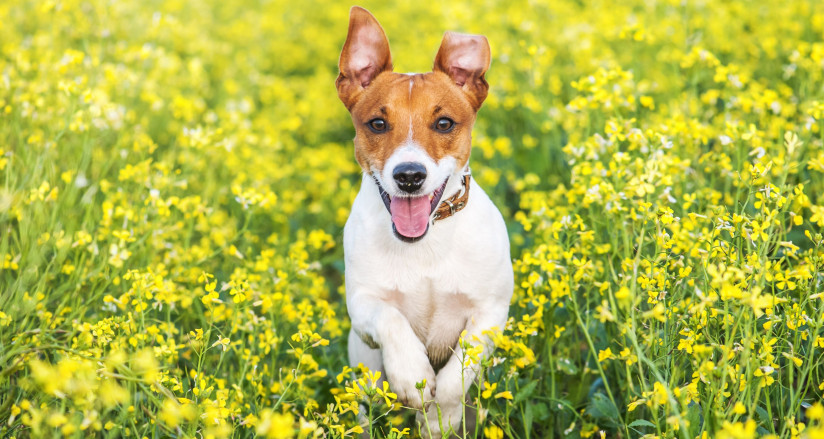How Can I Keep My Dog Safe Outdoors this Spring?
As flowers bloom and temperatures warm, it’s only natural to want to spend more time outside with your furry friend. But clean air and sunshine means pollen, plants, bugs, and dirt – and a host of potential health and safety issues. A little prevention goes a long way, so speak with your vet and follow these easy safety tips to enjoy the springtime.
Watch for Heartworms, Fleas, and Ticks
Heartworms, fleas, and ticks can be especially prevalent in springtime. Heartworm disease is a serious and potentially fatal parasitic illness transmitted by mosquitoes. The American Heartworm Society guidelines recommend all dogs be tested annually for heartworm infection, as larvae take 6-7 months to become adult worms. Your vet can both test for and create a preventative medication program to keep your dog heartworm-free.
Fleas and ticks can trigger a host of problems, from flea allergy dermatitis to Lyme disease and Rocky Mountain Spotted Fever. In large enough numbers, both ticks and fleas can cause a dangerous amount of blood loss, especially in young dogs. The most common prevention options, monthly spot-on topicals and oral tablets, are popular for their convenience and effectiveness.
As with all medical issues, prevention is key, so be sure to check with your vet for proactive recommendations to keep your dog free of parasites and in good health.
Pet-Proof Your Garden
Gardening is a natural fit for springtime, but a little pet-proofing can go a long way. Many plants and gardening supplies can be poisonous to our pups, so consult your vet for a list of toxic plants in your area so you can keep your dog away if they occur naturally.
Avoid pesticides and use natural alternatives instead. Similarly, if you have treated your lawn with fertilizers, herbicides, or insecticides, don’t let your dog walk on it until the toxic treatments have completely dried. You may also consider not gardening with your dog present. Your observant pup may think that digging and playing with plants is acceptable canine behavior!
Relieve Spring Time Allergies
Spring allergies are a natural consequence of blooming plants, grasses, and flowers for humans and dogs alike. Dogs often develop itchy skin (a condition called atopy) instead of sneezing. Be on the lookout for persistent scratching, licking, and biting, which may mean your pup is seeking relief from discomfort.
Oral medications are a great option if your dog shows signs of atopy for less than three months per year. In more severe cases, your vet can perform a skin test to pinpoint the allergies. In either instance, visit your veterinarian for diagnoses and recommended allergy treatments.
Identify and Treat Unusual Odors
Smelly dogs may be a sign of a number of things: dental disease, ear infection, oily skin, or a blocked anal gland. To tackle a potential issue, first identify where the smell is coming from:
- Mouth odor, for example, may indicate dental problems, digestive illness, or underlying internal diseases like kidney issues or diabetes. If you noticed discolored teeth or worse doggie breath than usual, ask your vet for a dental exam.
- If the skin inside your dog’s ears is red, sore to the touch, or emits a bad odor, have your vet check for an ear infection.
- Dogs with flaky dandruff or an oily, waxy feel to their coat along with a strong odor may have seborrhea, a common skin disorder that can be prevented through frequent baths with a medicated shampoo.
- Lastly, an infected anal gland can also be a source of odor and discomfort and will require veterinary attention for treatment.
Use Time Outdoors to Reinforce Training
Longer days and warmer temperatures mean more opportunities to refresh your training skills and strengthen your relationship with your furry friend. Nicer weather is a great excuse to reinforce leash training techniques and practice basics like walking to heel, coming when called, and gate manners that may have been less doable in the winter cold.
Start slowly and use each exercise to enhance your dog’s response to you, the family leader, as you continue to build a stronger, safer, and deeper relationship.
When spring has sprung, it should mean outdoor fun for everyone – pups included! Take these simple precautions to ensure a great season for you and your dog.
